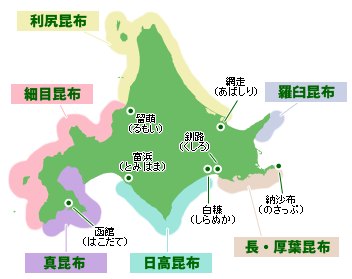
 kagomekonbu詳細を入力してください |  hidakakonbu植物学的な名は三石昆布ですが、日高地方で取られたものが、特に日高昆布と呼ばれています。 柔らかくて煮えやすく、味も良いので、いろいろな用途に使える万能昆布です。 |
|---|---|
 真昆布函館沿岸 特徴厚みがあり幅が広い。昆布の高級品。上品な甘味をもち、清澄なだしがとれる。 主な用途主にだし昆布として利用、佃煮、塩昆布など |  厚葉昆布産地 |
 kombumap産地 |  猫足昆布根こんぶの部分が猫の足のような形なので、この名がつきました。 |
 shisokonbu一汁一菜 |  kagomekonbuこれが天然の函館産、がごめ昆布!! みずみずしく光り輝く 籠の目に似た突起模様凸凹が、がごめの証!! |
Kind of Kombu
Ma-Konbu
The most typical kind of kelp. It is a very thick and wide konbu.
How to Use
There is an elegant sweetness that helps make a clear soup,
and it is well suited to making stew. The thickness of Ma-
konbu is also very suitable for being boiled.
Use of the Processed Goods
Used primarily as is, however it can be used for salt kelp
and Tororo kelp when boiled.
Rishiri-Konbu
There is a sweeter taste when compared to that of giant kelp. Rishiri-Konbu is hard with a salty taste. In particular, it has been used favourably in the traditional kaiseki cuisine of Kyoto.
How to Use
The taste has a rich aroma and high transparency that makes it useful for soup or stew. It goes particularly well with boiled tofu. In addition, it is delicious when served with pickles.
Use of the Processed Goods
Used primarily as it is, Rishiri-konbu is hard and does not
discolor from shaving. It can also be used in the exclusive
dim-Tororo kelp.
Rausu-Konbu
It’s formally known as the ‘Kelp of the Rishiri Ena.’
The broth is cloudy, but the soup has a rich, full-bodied scent
that is tinged with a soft yellowish hue. The taste of the soup is often referred to as ‘soup of the king.’
How to Use
Since this makes for a very rich soup, it is suitable for soup
stock, boiled as a stew.
Use of the Processed Goods
It is used primarily as is kelp. Other uses include things like, kelp tea, snacks, and simply boiled.
Hidaka-Konbu
(Mitsuishi kelp)
The botanical name is Mitsuishi kelp, but since it was taken
in the Hidaka region, it has become known as Hidaka kelp.
It is soft and easy to cook. The taste is good and serves to make this an all-purpose kelp that can be used in various applications.
How to Use
Hidaka kelp is soft and a very suitable ingredient for winding cooked food. The taste is good and suitable for soup kelp.
Use of the processed goods
Boiled kelp is widely used as a raw material with various
applications such as kelp winding.
Naga-Konbu
This kelp is produced in large amounts and is the most
elongated kelp.
It is popularly used as processing material.
Use of the Processed Goods
Used as an ingredient for Tsukudani , Konbumaki,
Nikonbu, Oden.
Hosome-Konbu
This kelp is from the first harvest of the year. It is sticky and strong with a detailed leaf shape.
Because it washes away towards the end of the normal first year, it is harvested in the summer of the first year.
Use of the processed goods
It is used as ingredients in Tororo-Konbu and Natto-Konbu.
Gagome-Konbu
The name comes from the irregularities in the algal cells’ surface that give it the look of a sticked basket.
This kelp has a very strong stickiness. There have been noted health benefits due to the strong stickiness of this seaweed.
Appa-Konbu
It is also known as Gaggara kelp. It grows in the same area
as the long kelp.
As the name suggests, this kelp characterised by the thickness of its leaves.
Use of the Processed Goods
It is utilised for processing in things such as, Tsukudani,
Siofuki-Konbu, Oboro-Konbu and Battera
Nekoashi-Konbu
It earns its name due to part of the root kelp being shaped
like a cat's paw.
Use of the processed goods
It is often used in Tororo-Oboro-Konbu.
Yayan-Konbu
The name comes from the taste of the sea roar.
Kukinaga-Konbu
It is dark brown in color with wide leaves.
The thin edges of this kelp make many folds.






